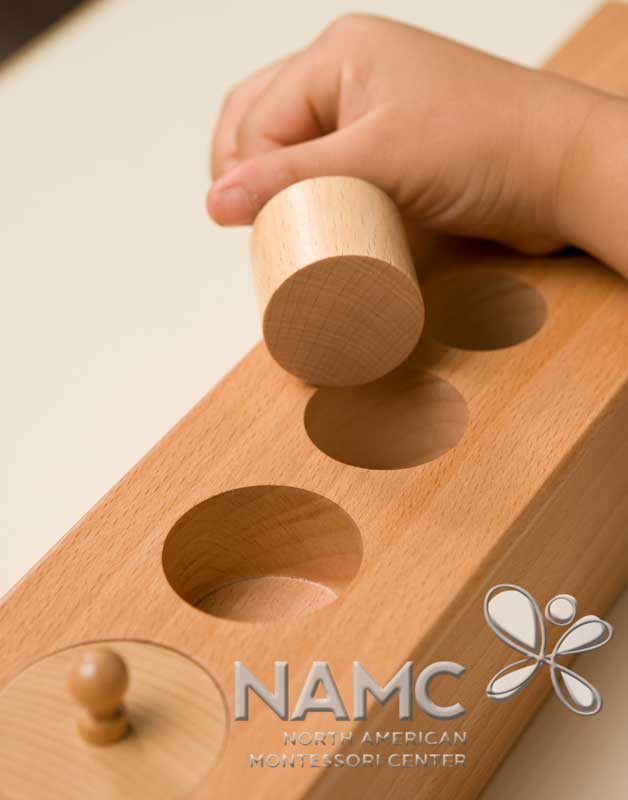
In a previous blog, we discussed the value of inclusion and how Montessori’s tenet of following the individual needs of the child makes it inherently inclusive. The Circle of Inclusion Project (University of Kansas) and Raintree Montessori (Lawrence, Kansas) listed 11 specific ways in which Montessori education addresses the needs of all children, including those with disabilities. Included in this list is “Materials with a built-in control of error.” In today’s blog, Michelle kindly shares her classroom experiences to provide real-life examples of how Montessori meets that specific goal.
The didactic material controls every error. The child proceeds to correct himself, doing this in various ways.
—Maria Montessori
The Montessori Method, p. 171.
The Montessori Method, p. 171.
Dr. Montessori’s words remind us of the significance of control of error in the Montessori environment. We give children the materials they need to use in a carefully prepared environment, and let the materials, not the adults, do the teaching. Allowing children to discover answers independently and in their own time is another way that Montessori education addresses the needs of all children.

Circle of Inclusion: Montessori Materials with a Built-In Control of Error
Recently, a NAMC student contacted me about a challenge she was facing her infant/toddler environment. She found that the children were getting wet and making a mess with the practical life water-based activities. To solve the problem, she was thinking of removing the activities altogether. She said the children really loved the activities and it was a very popular area of the classroom, but she was tired of cleaning up after them.
Her concern opened the door to a conversation about control of error. I reminded her that water-based activities have a built-in control of error. When done correctly, there are few spills. And if there is a spill, the child is shown how to wipe it up as part of the complete work cycle. When receiving a presentation about pouring water, the child learns the necessary steps for the entire process, giving him the know-how to complete the activity independently, the understanding to know when it is done correctly, and the ability to make corrections when he makes a mistake.

The sensorial materials are a wonderful example of how the control of error can be built in to the design of the Montessori materials.
For instance, each cylinder in a Cylinder Block fits perfectly in only one hole. Similarly, in the Montessori Bells the black and white set is a control for the brown set of bells. The built-in control of error helps children experience for themselves if they are using the material correctly without the need for relying upon or seeking approval from the adult.Every effort should be made to see that the materials offered to a child contain in themselves a control of error. … The control of error through the material makes a child use his reason, critical faculty, and his ever increasing capacity for drawing distinctions. In this way a child's mind is conditioned to correct his errors even when these are not material or apparent to the senses.
—Maria Montessori
The Discovery of the Child, p. 103.
The Discovery of the Child, p. 103.
Another NAMC student recently mentioned that she was considering removing the control of error cards from her lower elementary math shelves. She was afraid that the children would “cheat” and not do the work themselves. During the previous year, she had observed that some students would continuously check their work as they did it. Her concern was that the students were becoming too dependent on the control sheets. I pointed out that the students who used the controls of error the most were the ones who also found the most benefit in having access to the control sheets. If they were confident in their skills, the students would not have needed the constant reinforcement. When children are confident in their abilities, they do not need to constantly check their work. Having the control of error available to students is not a crutch or a ‘cheat’; it empowers them to continue working, revising their work along the way. Having to ask the teacher for the control inhibits spontaneous learning and once again puts the teacher in the position of power, stripping it away from the child.
Dr. Montessori believed that self-correction empowers the child’s sense of self-worth. Experience and repetition allows the child to discover for themselves and work independently.
As much as possible, NAMC’s web blog reflects the Montessori curriculum as provided in its teacher training programs. We realize and respect that Montessori schools are unique and may vary their schedules and offerings in accordance with the needs of their individual communities. We hope that our readers will find our articles useful and inspiring as a contribution to the global Montessori community.
© North American Montessori Center - originally posted in its entirety at Montessori Teacher Training on Tuesday, February 7, 2017.
© North American Montessori Center - originally posted in its entirety at Montessori Teacher Training on Tuesday, February 7, 2017.

0 comments:
Post a Comment
Have questions or comments? Let us know what you thought about this article!
We appreciate feedback and love to discuss with our readers further.